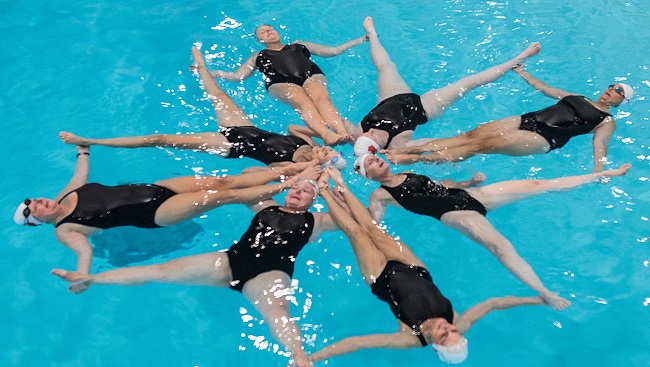Synchronized swimming, sometimes known as “underwater ballet,” is much more difficult than it appears at first glance. As a creative endeavour, it necessitates physical prowess, suppleness, and poise.
The Los Angeles Olympics of 1984 were the first to officially include it. Some of the benefits of synchronised swimming on one’s health are listed below.
Contents
Can Synchronized Swimmers Touch The Bottom
Members of a synchronised swimming team are not allowed to touch the pool floor throughout their routines.

Among the many required movements for routines are twists, pointed toes, lifts, and splits. Performers in the water do not touch the bottom of the pool as they do defying manoeuvres. They swim in depths of at least nine feet during training and competition. As they do so, they encourage one another.
Invincible Perseverance
The average synchronised swimmer puts about six hours of practise per week. Cross-training consists of six hours in the pool and two hours on land. Ballet, gymnastics, dancing, and Pilates are all part of their routines. The effort and strength required for this task are enormous.
The Mental Benefits of Synchronized Swimming
Keeping a memorised routine in mind is a must for this sport, therefore the brain has to put in extra effort. The brain builds new neural pathways and maintains the health of the ones you already have when you engage in mental exercise. Another plus for this activity.
Improves Mental and Emotional Health
Physical activity results in the release of endorphins. Taking part in this sport requires a lot of movement, and this movement releases endorphins, or “feel good” hormones. Depression and overall mood can benefit from synchronised swimming.
Raised Levels of Intelligence
Synchronized swimming improves concentration since it requires multitasking. Counting, rhythm, coordination, and mental imagery are just few of the abilities they routinely practise.
Long Term Absence of Breathing
While doing a four-minute routine, most expert synchronised swimmers can go two minutes without needing to breathe.
Teamwork is Crucial
When people put their trust in one another, they may do more. All positions in the pool must be filled by swimmers of equal skill. A total of almost a thousand separate actions are taken by the group of eight. No matter how seemingly insignificant, every change must be carefully considered.
Healthier Heart and Blood Vessels
When it comes to cardiovascular health, swimming is unparalleled. You’ll have 40% less chance of developing coronary heart disease as a result of this.
Expands The Lungs
Training for long periods of time in the water helps swimmers develop stronger lungs. Better oxygenation of the body is facilitated by a larger lung capacity. As a result, your health as a whole improves.






























